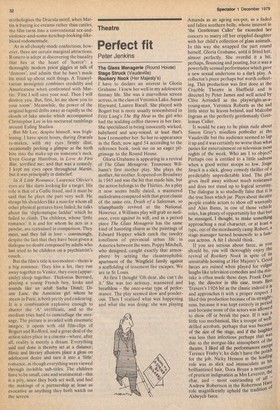Cinema
Blood money
Peter Ackroyd
Martin (Cinecenta X') A Little Romance (Classic 'A') 'How old are you Martin?' A sullen and unattractive American teenager, looking like a cat on a cold tin roof, shuffles into view. `I'm 84'. Martin is a kitchen-sink version of the Dracula myth, but one that. begs all the questions. Is this taciturn high school drop-out a vampire, a progeny of the doomed Transylvanian family, or is he a brooding psychopath whose shadowy cerebellum is haunted by celluloid legends of necks and stakes? Difficult to say, and impossible to care.
The film has been made by George A. Romero, chiefly remembered for Night of the Living Dead, a film that made lowbudget horror as acceptable to serious cri tics as Hammer Horror made it 'camp'. This picture trails somewhere in the same direction; the dialogue is rudimentary and has been siphoned through an echo-chamber, so that most of the conversations appear to be taking place in an adjacent room. The editing is as subtle as a stake through the heart, and the whole film has the same damp and wooden texture which haunts the series of small, brightly-lit rooms in which most of the action takes place. Martin is a Nosferatu among the supermarkets; he wanders into sex-shops, bear ing merchandise as brutal as anything he might care to inflict; he delivers groceries to bored American housewives, the living dead — albeit victims of a different culture; he talks about himself to a radio 'call-in' host, whose inane prattle rivals any of the incantations which Bram Stoker imagined. The point, in other words, is made: and with a vengeance. To be a vampire in an Ameri can city is simply to become one of a crowd. But this is a sociological, and not a cinematic, point. As ' soon as Romero de mythologises the Dracula motif, when Martin is buying ice-creams rather than castles, the film turns into a conventional sex-andviolence-and-some-ketchup-looking-like blood rodomontade.
As in all cheaply-made confections, however, there are certain marginal attractions.
Romero is adept at discovering the banality that lies at the heart of 'horror': a thoroughly modern priest giggles at talk of 'demons', and admits that he hasn't made his mind up about such things. A Transylvanian immigrant combines credulity and Americanese when confronted with Martin: 'First I will save your soul. Then I will destroy you. But, first, let me show you to your room'. Meanwhile, the power of the original legend drifts away as rapidly as the clouds of fake smoke which accompanied Christopher Lee in his nocturnal ramblings around Ealing Studios.
, But Mr Lee, despite himself, was frightening. I have spent hours, during Dracula re-makes, with my eyes firmly shut, occasionally peeking a glimpse as the teeth bite into the make-up on someone's neck. Even George Hamilton, in Love At First Bite, terrified me; and that was a comedy. I kept my eyes open throughout Martin, but it was principally in disbelief.
In A Little Romance, Laurence Olivier's eyes are like darts looking for a target. His role is that of a Gallic fraud, and it must be said that he plays the part very well. He shrugs his shoulders like a man for whom all other physical gestures have failed; he talks about the `diplomatique laddar' which he failed to climb. The children, whose 'little romance it is and for whom he acts as a pandar, are restrained in comparison. They meet, and they fall in love — convincingly, despite the fact that they have been given a dialogue no doubt composed by adults who last tried to be children on a psychiatrist's couch.
But the film's title is too modest — theirs is a big romance. They kiss a lot, they run away together to Venice, they even (apparently) .sleep together. Thelonius Bernard, playing a young French boy, looks and sounds like an adult Sacha Distel; Diane Lane, the American girl whom he meets in Paris, is both pretty and endearing. It is a combination explosive enough to shatter the 'A' certificate, and so the medium tries hard to camouflage the message. The picture is invaded with cinematic images; it opens with old film-clips of Bogart and Redford, and a great deal of the action takes place in a cinema where, after all, reality is merely a dream. Everything said and done is thereby set at a distance; filmic and literary allusions place a gloss on adolescent desire and turn it into a 'little' romance, as though everything were viewed through invisible sub-titles. The children have to be small, cute and sentimental—this is a pity, since they both act well, and had the makings of a partnership at least as evocative as anything they both watch on the screen.












































 Previous page
Previous page